Overcome life's tempests with an insightful exploration into the profound symbolism of storms in the Bible.
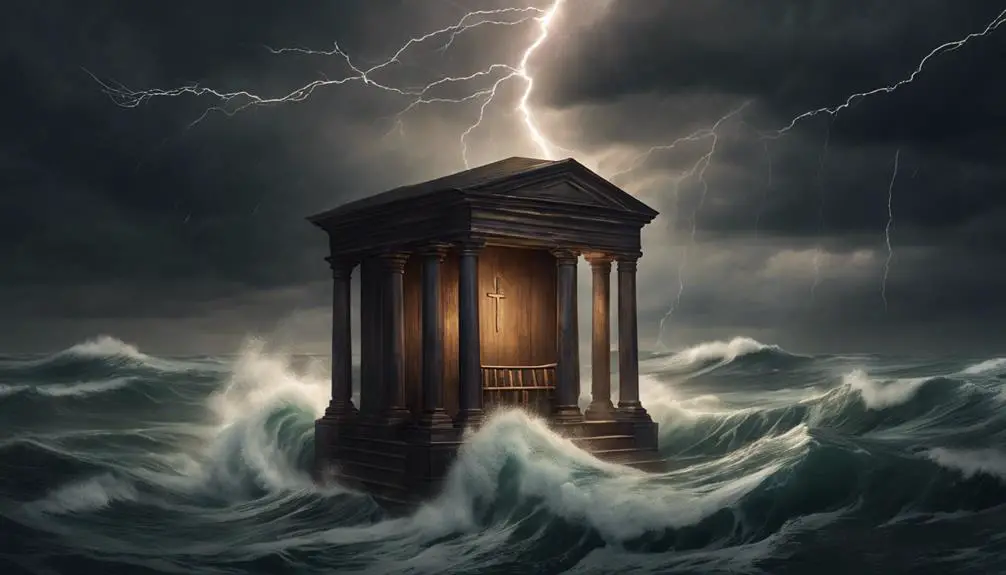
Storms in the Bible Sermon
Isn't it striking how often storms appear in the Bible? You've likely heard sermons on Noah's Ark, Jonah's tempestuous whale encounter, or Jesus calming the Sea of Galilee. But have you ever considered why these weather phenomena are so prevalent in these spiritual narratives?
Storms in the Bible aren't just about the weather; they're metaphors for life's trials and tribulations. Let's explore these biblical tempests together, uncovering the deeper meaning that can guide us through our own life's storms. What might we unearth in these ancient texts to help us weather our modern storms?
Key Takeaways
- Storms in biblical narratives symbolize divine judgement, authority, intervention, and control.
- Obedience, trust, and faith in God are prominent themes in these narratives.
- Divine intervention and control are evident in stories of biblical storms.
- Stories of storms in the Bible provide encouragement for believers during times of trials and tribulations.
Noah's Ark and the Great Flood
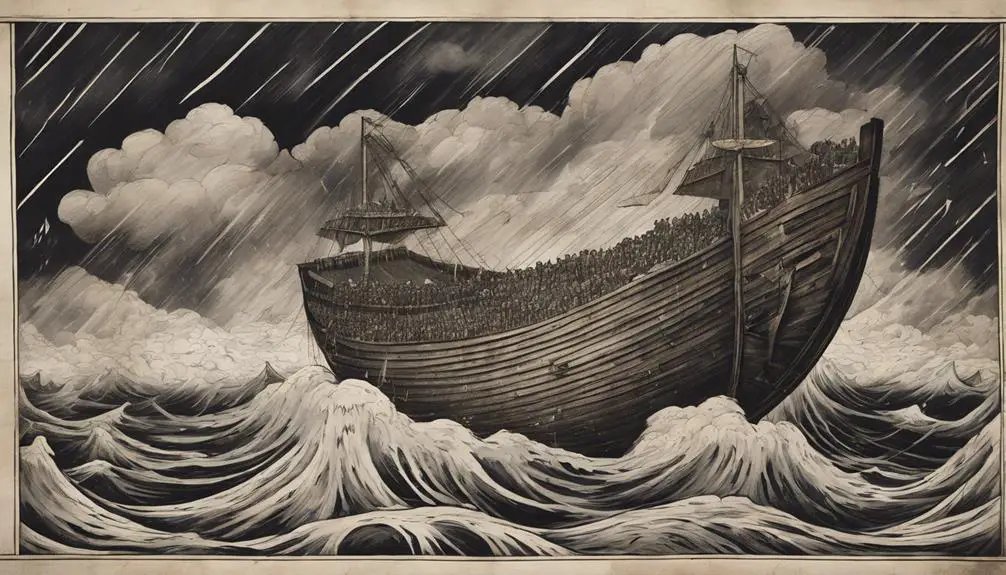
Perhaps one of the most renowned storms in the Bible is the deluge that led to Noah's Ark and the Great Flood, a divine act of both judgment and mercy. This biblical narrative isn't just a story; it's laden with profound flood symbolism that speaks volumes about God's character and His dealings with humanity.
The Great Flood, in essence, represents God's judgment on a wayward and sinful world. Yet, alongside this, it also symbolizes His profound mercy. You see, God didn't just destroy; He also preserved. This duality is where the ark construction comes into play.
The Ark, meticulously crafted by Noah under God's instruction, stands as an emblem of God's salvation. Its construction, painstaking and precise, serves to underscore God's attention to detail and His unwavering commitment to preserving life amidst destruction. It's a physical testament to God's promise of deliverance for those who obey and trust Him.
Through the lens of faith, the tale of Noah's Ark and the Great Flood isn't merely a historical or mythical event. It's a powerful reminder of God's righteous judgment, His merciful salvation, and His unchanging faithfulness.
Jonah's Storm and Whale Encounter
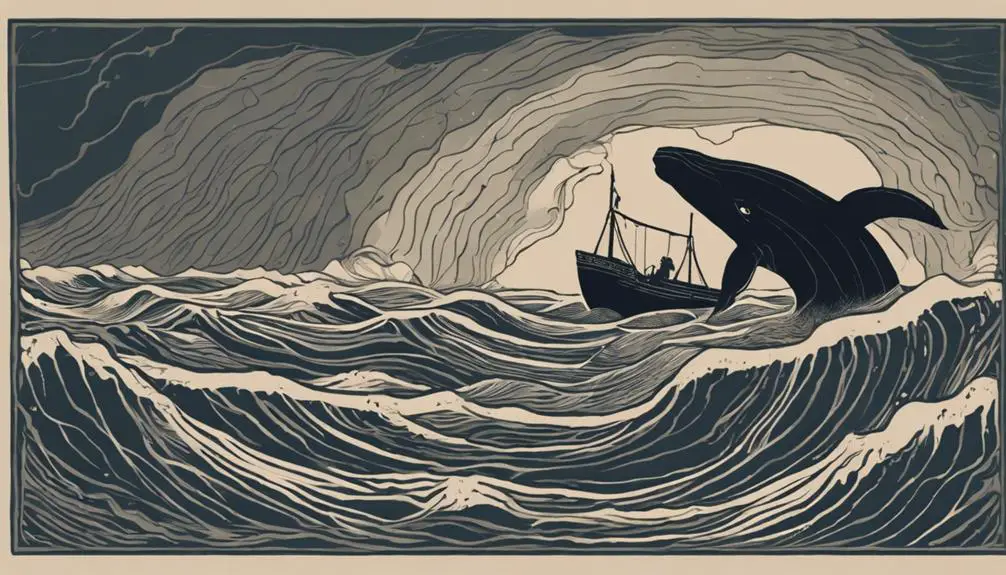
While the tale of Noah's Ark showcases God's judgment and mercy, the story of Jonah's encounter with a storm and a whale offers another perspective on divine intervention and obedience.
You see, Jonah was a prophet of God who was tasked with delivering a message to the city of Nineveh. Yet, the prophet's disobedience led him to flee in the opposite direction, triggering a sequence of events that revealed God's omnipotence.
During his escape, a violent storm was sent by God as divine intervention, making it impossible for Jonah to continue his wayward journey. As the tempest raged, Jonah was thrown overboard, where he was swallowed by a giant whale. This dramatic episode served not only as a symbol of God's authority over nature, but also His control over individual destinies.
In the belly of the whale, Jonah's disobedience was met with God's merciful discipline. Here, Jonah repented and was eventually spat out onto dry land. His story illustrates that even in our rebellion, God can use storms – literal and figurative – to redirect us back to His will.
Jesus Calming the Sea of Galilee
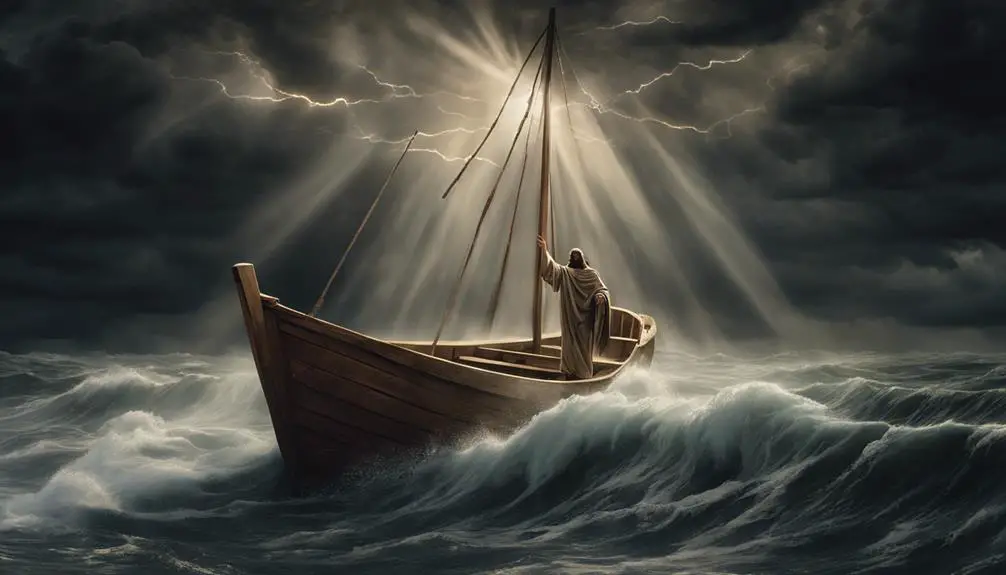
Transitioning from Old Testament accounts, we now explore a New Testament event where Jesus demonstrates His divine authority over nature by calming the storm on the Sea of Galilee. This episode, a clear testament to Miraculous Intervention, underscores the theme of Faith Amidst Chaos.
In Mark 4:35-41, the disciples, seasoned fishermen accustomed to Galilean storms, find themselves terrified by a tempest that threatens to sink their boat. Your understanding deepens when you realize that their fear must've been fueled by the ferocity of this particular storm. Yet, Jesus, seemingly unconcerned, is asleep in the stern.
In desperation, they wake Jesus, questioning His care for them. His response, 'Peace, be still,' not only silences the wind and waves but also reveals His divine power. The disciples' fear transforms into awe, as they grapple with the realization of Jesus' authority over the elements.
Here's the crux: Jesus' calming of the Sea of Galilee isn't merely about an impressive display of divine power. It's about faith—faith that remains steadfast amidst chaos, faith that trusts in His divine care even when circumstances seem dire. The storm may rage, but remember, Jesus is in the boat with you.
Paul's Shipwreck in Acts
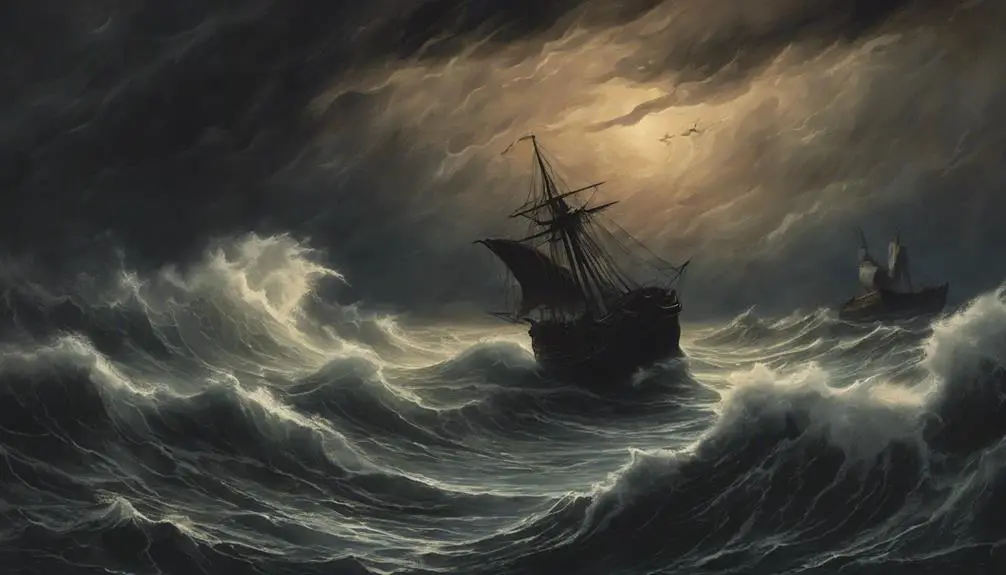
Moving from the Sea of Galilee to the Mediterranean, we encounter another dramatic maritime event in the Bible – Paul's shipwreck in Acts. This is a tale of survival and Divine Intervention, of wisdom in the face of calamity, and a testament to Paul's faithfulness.
Let's paint the picture:
- A mighty storm rages, battering the ship carrying Paul and other prisoners to Rome.
- The crew's efforts to save the ship are futile. The vessel is torn apart by the tempest.
- Stranded on the island of Malta, Paul remains unshaken, his faith unwavering.
Paul's encounter with the storm shows his courage and trust in God. Despite the chaos and uncertainty, Paul's faithfulness remains unbroken. He reassures the crew, prophesying their survival. This prophecy is a clear depiction of Divine Intervention. Not a single life is lost, just as Paul had foretold.
Paul's shipwreck serves as a powerful reminder of God's providence during tempestuous times. In the midst of the storm, God's presence is a beacon of hope. His Divine Intervention, coupled with Paul's unwavering faith, are key elements in this dramatic biblical narrative.
Applying Biblical Storm Lessons Today
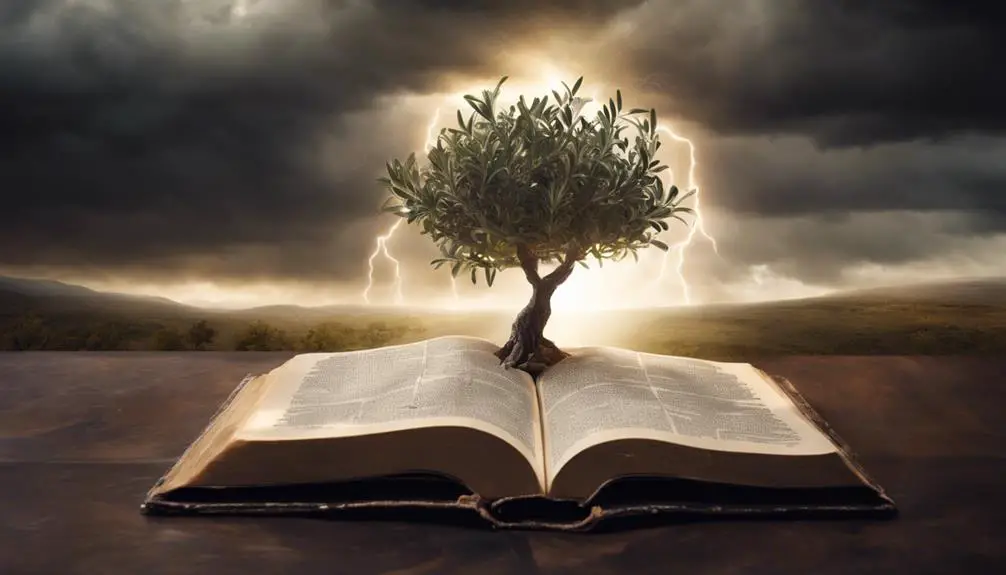
How can we apply the lessons from these biblical storms in our daily lives today? The Bible is rich with storm resilience lessons that can guide us in navigating the tempests we encounter in life. It teaches us how to find spiritual strength in adversity.
Here's a table that illustrates how we can apply these lessons:
Biblical Storm |
Modern Application |
|---|---|
Noah's Flood |
Trust in God's promises during life's overwhelming situations. |
Jonah's Storm |
Obedience to God's commands brings peace in the midst of turmoil. |
Job's Storms |
Maintain faith and integrity even during trials and suffering. |
Jesus Calming the Storm |
Jesus has power over our storms; we need to trust Him. |
| Paul's Shipwreck | Even when things seem hopeless, God can bring about good.
Through these examples, you'll see that the storms in the Bible symbolize life's challenges. They're not just stories but lessons about faith, obedience, trust, and hope. So, when you face the storms of life, remember these biblical teachings. Let them strengthen your faith, guide your actions, and bring you peace amidst the turmoil. Remember, as believers, we have the assurance that no storm is too great for God.
Frequently Asked Questions
What Other Biblical Figures Experienced Significant Storms Not Mentioned in These Sections?"
You're curious about other biblical figures who faced significant storms, not mentioned in these sections. Well, Jonah encountered a massive storm at sea, a powerful metaphor for God's wrath for his disobedience.
Also, Paul survived a fierce tempest during his journey to Rome, teaching us invaluable storm survival lessons about faith and perseverance.
These instances amplify the role of storms as both literal and metaphorical challenges in the biblical narrative.
How Did the Concept of Storms Evolve in the Bible From the Old Testament to the New Testament?"
In the Old Testament, storms often symbolized God's power and judgment. However, in the New Testament, they took on a more metaphorical significance, representing spiritual or personal turmoil. Biblical storm narratives evolved to reflect this shift, emphasizing faith's role in weathering life's storms.
For example, Jesus calming the storm in the New Testament symbolizes faith's power to bring peace amidst chaos. So, you see, storms' concept evolved significantly from the Old to the New Testament.
How Were Storms Perceived or Interpreted in the Cultural Context of Biblical Times?"
In biblical times, storms were perceived as powerful symbols and divine communication. They embodied God's might, his intervention in human affairs, and even his wrath. Yet, they're not just omens of destruction. They can also signify cleansing and renewal.
It's critical to note that these interpretations are deeply rooted in the cultural context of that era, reflecting their understanding of nature and divine interactions.
Are There Any Symbolic Representations of Storms in Other Religious Texts as Well?"
Yes, there are symbolic representations of storms in other religious texts. In the Quran, storm imagery often signifies God's power and judgement.
Meanwhile, Buddhism uses storm metaphors to communicate the tumultuous nature of human emotions and the path to inner peace.
It's fascinating how these texts use storms to convey profound spiritual concepts.
What Can We Learn From the Bible About the Emotional and Psychological Impact of Storms on Individuals?"
You can glean from the Bible that storms often serve as metaphors for life's trials. They symbolize emotional and psychological turmoil. However, they also highlight emotional resilience in storms.
In enduring these tempests, individuals find strength and grow in their faith. Storms, although daunting, aren't just destructive forces but opportunities for inner growth and spiritual deepening. They teach us about resilience, faith, and the transformative power of overcoming hardship.
Conclusion
So, you see, storms in the Bible are more than just tales of weather. They're lessons on faith, resilience, and divine intervention.
The Great Flood, Jonah's ordeal, Jesus calming the Sea of Galilee, and Paul's shipwreck, all echo that God uses storms, not to break us, but to strengthen and guide us.
Let's apply these lessons today, reminding ourselves that in our personal storms, God's presence and purpose remain constant.

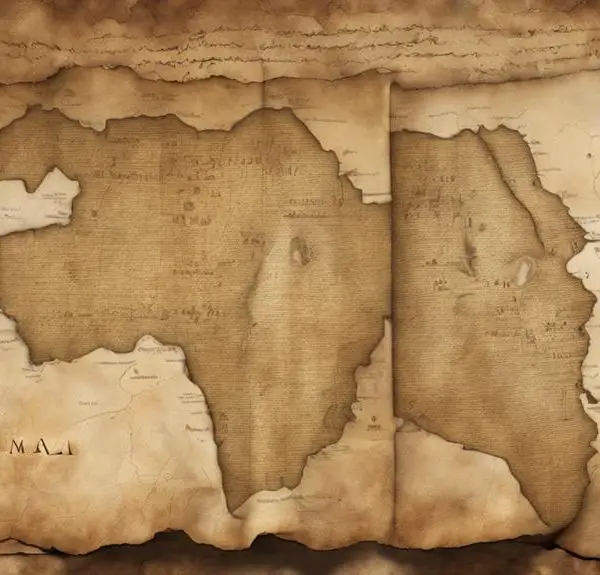
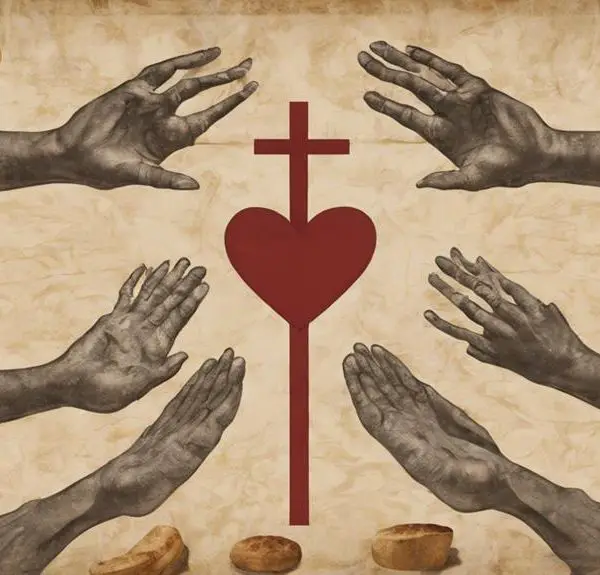
Sign up